Biographies
advertisement
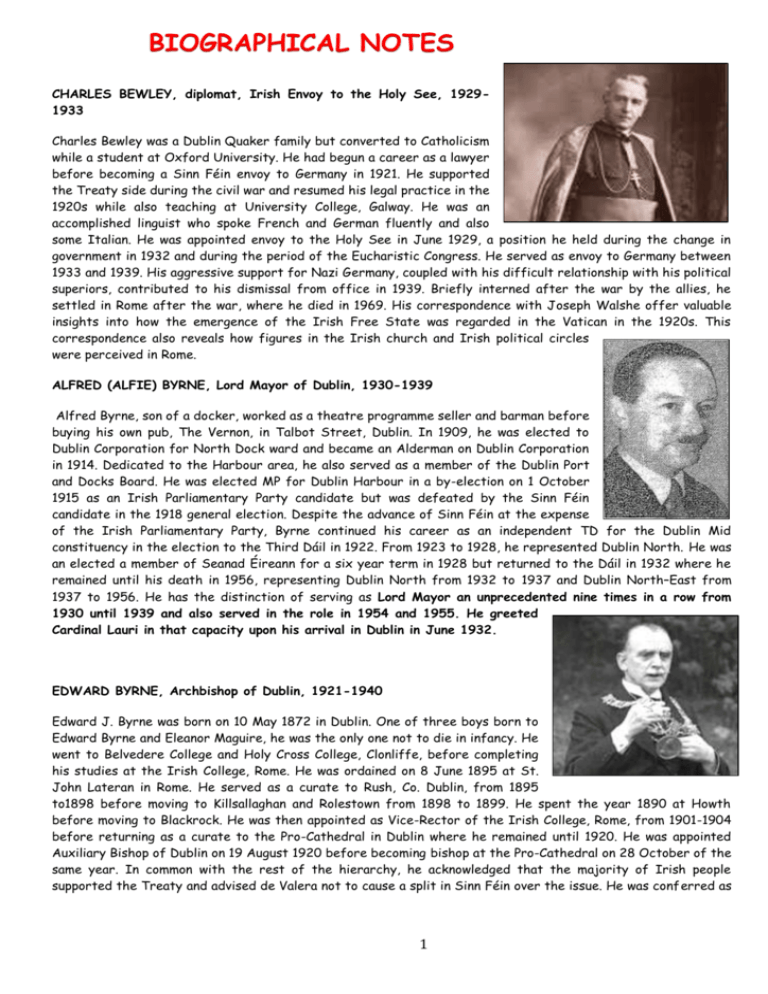
BIOGRAPHICAL NOTES CHARLES BEWLEY, diplomat, Irish Envoy to the Holy See, 19291933 Charles Bewley was a Dublin Quaker family but converted to Catholicism while a student at Oxford University. He had begun a career as a lawyer before becoming a Sinn Féin envoy to Germany in 1921. He supported the Treaty side during the civil war and resumed his legal practice in the 1920s while also teaching at University College, Galway. He was an accomplished linguist who spoke French and German fluently and also some Italian. He was appointed envoy to the Holy See in June 1929, a position he held during the change in government in 1932 and during the period of the Eucharistic Congress. He served as envoy to Germany between 1933 and 1939. His aggressive support for Nazi Germany, coupled with his difficult relationship with his political superiors, contributed to his dismissal from office in 1939. Briefly interned after the war by the allies, he settled in Rome after the war, where he died in 1969. His correspondence with Joseph Walshe offer valuable insights into how the emergence of the Irish Free State was regarded in the Vatican in the 1920s. This correspondence also reveals how figures in the Irish church and Irish political circles were perceived in Rome. ALFRED (ALFIE) BYRNE, Lord Mayor of Dublin, 1930-1939 Alfred Byrne, son of a docker, worked as a theatre programme seller and barman before buying his own pub, The Vernon, in Talbot Street, Dublin. In 1909, he was elected to Dublin Corporation for North Dock ward and became an Alderman on Dublin Corporation in 1914. Dedicated to the Harbour area, he also served as a member of the Dublin Port and Docks Board. He was elected MP for Dublin Harbour in a by-election on 1 October 1915 as an Irish Parliamentary Party candidate but was defeated by the Sinn Féin candidate in the 1918 general election. Despite the advance of Sinn Féin at the expense of the Irish Parliamentary Party, Byrne continued his career as an independent TD for the Dublin Mid constituency in the election to the Third Dáil in 1922. From 1923 to 1928, he represented Dublin North. He was an elected a member of Seanad Éireann for a six year term in 1928 but returned to the Dáil in 1932 where he remained until his death in 1956, representing Dublin North from 1932 to 1937 and Dublin North–East from 1937 to 1956. He has the distinction of serving as Lord Mayor an unprecedented nine times in a row from 1930 until 1939 and also served in the role in 1954 and 1955. He greeted Cardinal Lauri in that capacity upon his arrival in Dublin in June 1932. EDWARD BYRNE, Archbishop of Dublin, 1921-1940 Edward J. Byrne was born on 10 May 1872 in Dublin. One of three boys born to Edward Byrne and Eleanor Maguire, he was the only one not to die in infancy. He went to Belvedere College and Holy Cross College, Clonliffe, before completing his studies at the Irish College, Rome. He was ordained on 8 June 1895 at St. John Lateran in Rome. He served as a curate to Rush, Co. Dublin, from 1895 to1898 before moving to Killsallaghan and Rolestown from 1898 to 1899. He spent the year 1890 at Howth before moving to Blackrock. He was then appointed as Vice-Rector of the Irish College, Rome, from 1901-1904 before returning as a curate to the Pro-Cathedral in Dublin where he remained until 1920. He was appointed Auxiliary Bishop of Dublin on 19 August 1920 before becoming bishop at the Pro-Cathedral on 28 October of the same year. In common with the rest of the hierarchy, he acknowledged that the majority of Irish people supported the Treaty and advised de Valera not to cause a split in Sinn Féin over the issue. He was conferred as 1 Archbishop of Dublin on 29 August 1921. His motto was In Te Domine Speravi (In Thee, O Lord, I Have Hoped). He oversaw celebrations of the Centenary of Catholic Emancipation in 1929 and the Eucharistic Congress in 1932. He remained as Archbishop until his death on 9 February 1940. GK CHESTERTON, writer, journalist, critic and Christian polemicist Gilbert Keith Chesterton began a journalistic career as a freelance art and literary critic in 1902, writing a weekly opinion column in the Daily News, followed in 1905 by a weekly column in The Illustrated London News, for which he continued to write for the next thirty years. Distinguished by his trademark cape, crumpled hat and swordstick in hand, Chesterton became a respected thinker and commentator on politics, economics and philosophy as well as a prolific writer, producing many books, plays and poems as well as essays. Known for his wit and lively style of writing. A critic of modernism, Chesterton became an apologist for Christian values and converted to Catholicism from Anglicanism. His experiences as an observer of the Eucharistic Congress of 1932 are recorded in his book Christendom in Dublin, where he writes lyrically of the profound impact the week’s events had on him, especially the authentic engagement of the city’s poor.. WILLIAM T COSGRAVE, leader Cumann na nGaedheal and President of the Executive Council of the Irish Free State, 1922-1932 William T. Cosgrave attended the first Sinn Féin convention in the Rotunda in Dublin in 1905 and was elected to Dublin Corporation in 1909. He joined the Irish Volunteers on their formation in 1913 and fought in the 1916 Rising. He was interned at Frongoch in Wales until January 1917. He was elected Sinn Fein MP for Kilkenny North at a by-election in August 1917, and was re-elected in the 1918 general election. He sat in the first Dáil and was minister for local government from April 1919 to September 1922. He supported the Anglo-Irish Treaty of 1921 and succeeded Michael Collins as chairman of the Provisional Government and minister for finance in July 1922. He also succeeded Arthur Griffith as president of the Dáil government in August 1922. In September 1922 he became the first president of the executive council of the Irish Free State. He also served as Minister for Defence (1924) and Minister for Justice (1927). He set about establishing an administration to enable the country to recover from the effects of civil war. In April 1923, Cosgrave founded Cumann na nGaedheal and became its first leader. During its term of office, Cosgrave’s government helped to lay the foundations of the new state, devoting particular attention to the Shannon Scheme, local government, the civil service, the police, the courts, currency, intoxicating liquor and fisheries. Growing economic problems and the emergence of Fianna Fáil led to his party relinquishing power in 1932. A devout Catholic, Cosgrave was made a Knight of the Grand Cross of the Order of Pius IX in 1925 and enthusiastically supported Ireland’s hosting of the 1932 Eucharistic Congress, even though he lost power before the event took place. EAMON DE VALERA, president of Fianna Fáil and President of the Executive Council 1932 Eamon de Valera’s status as one of the most influential political figures in Irish history has its origins in his prominent role in the 1916 Rising, after which he was elevated to the leadership of Sinn Féin and the Irish Volunteers in 1917 and the position of President of the First Dáil in 1919. He led the nationalist movement through the War of Independence with Britain 2 but opposed the Treaty that followed in 1921. He supported the anti-Treaty side in the civil war and led Sinn Féin up to 1926, before founding Fianna Fáil in that year, leading the party into government in 1932. He sought to emphasise Irish sovereignty and independence from Britain by working to destabilise the Anglo-Irish Treaty and opposing partition. De Valera‟s relationship with the Catholic Church was complex. His support for the anti-Treaty side during the civil war was at odds with the hierarchy, who strongly supported the Cumann na nGaedheal government and moved to excommunicate those involved in anti-Treaty violence. The Vatican remained suspicious of de Valera after 1932 at a time when distrust of communism and fear of revolutionary movements was at its height. Yet, the Fianna Fáil government participated in the Eucharistic Congress celebrations very enthusiastically, with de Valera himself playing a prominent role, and de Valera himself was deeply Catholic. De Valera also maintained close friendships with many clerical figures, including Archbishop McQuaid, with whom he consulted on the new constitution in 1937. PIETRO GASPARRI, Cardinal Secretary of State to the Holy See, 19141930 Pietro Gasparri was made a cardinal in 1907, and served as the Cardinal Secretary of State from 1914 to 1930 under Pope Benedict XV, who succeeded Pius X in 1914. In this role, he oversaw the establishment of diplomatic relations between the Free State and the Holy See and the nomination of Paschal Robinson as the first papal nuncio to Ireland. Under Gasparri's leadership, the Vatican successfully concluded a record number of diplomatic agreements with European governments, many of which were in charge of new states created after World War I. He was also faced with handling the emergence of the first communist state in Russia after the war, which rejected both the Church and religion entirely. His major achievement was negotiating the Lateran Treaty between the Vatican and Mussolini’s Italian government in 1929, thus ending the sixty-year conflict between the Vatican and the Kingdom of Italy. He was succeed as Secretary of State by Eugenio Pacelli, later Pope Pius XII and died in November 1934. LORENZO LAURI, Cardinal Papal Legate to the Eucharistic Congress, 1932 Lorenzo Lauri was born in Rome in 1864. He attended the Pontifical Roman Seminary (where he later became a teacher) and was ordained as a priest in 1887. He worked in Peru and became a bishop in 1917. He was the Pope‟s chief advisor in Peru until full diplomatic relations between the Papacy and Peru were established in 1921. Lauri was created a full cardinal priest in 1927. After his service as Papal Legate in Dublin in 1932, he participated in the conclave (election by cardinals of a new pope) in1939 and shortly afterwards was named Camerlengo [cardinal who manages the pope’s secular affairs]. He died in 1941 and was buried at the Campo Verano Cemetry in Rome. JOSEPH MACRORY, Cardinal Archbishop of Armagh and Catholic Primate of All-Ireland, 1928- 1945 Joseph MacRory was ordained to the priesthood in September 1885 and served as the first president of St. 3 Patrick's Academy, Dungannon from 1886 to 1887. A member of the Gaelic League, he taught Scripture and Modern Theology at St Mary's College, Oscott in England until 1889, when he was appointed Professor of Scripture and Oriental Languages in Maynooth College. In 1906, he co-founded the journal Irish Theological Quarterly. In 1912 he was made Vice President of Maynooth. He was appointed Bishop of Down and Connor by Pope Benedict XV on 9 August 1915 and adopted the motto Fortis in Fide (`’Strong in Faith‟). In June 1928 he was promoted to the role of Archbishop of Armagh and thus Primate of All Ireland and in December 1929, Pope Pius XI made him a cardinal. He headed the Irish Church throughout the Eucharistic Congress celebrations. MacRory was an outspoken critic of social injustice but was also controversial for his criticism of Protestantism and partition in Ireland.. JOHN MCCORMACK, Papal Count, internationally renowned tenor, singer at Pontifical High Mass at 1932 Eucharistic Congress John Francis McCormack, the world famous international tenor, was born in June 1884 in Athlone. The fourth of eleven children, he was educated by the local Marist Brothers and later attended Summerhill College, Sligo. In 1903, his singing prowess earned him the gold medal at the Dublin Feis Ceoil. In 1906, he married Lily Foley, with whom he had two children, and also made his operatic début in Italy, performing in Savona. A year later, he became the youngest principal tenor at the famous Covent Garden opera. In 1909 he began his career in America, with a growing reputation as an accomplished performer of Italian and French operatic arias. In 1911, he toured Australia and by the following year, he was increasingly associated with concert performances more than opera appearances, such was the height of his fame and popularity. He made hundreds of recordings in the first two decades of the twentieth century and also broadcast regularly on radio and even in some films. He was the first artist to record the famous World War I song "It's a Long Way to Tipperary" in 1914 but was also associated with Irish nationalist songs and supported the Home Rule movement. McCormack was a devout Catholic and was the recipient of numerous honours from the Church, including the title of Papal Count, in 1928 in recognition of his work for Catholic charities. He famously performed Panis Angelicus at the Pontifical High Mass that brought the Eucharistic Congress of 1932 to a close. JOHN CHARLES MCQUAID, President of Blackrock College, 19311939; Archbishop of Dublin 1940-1973 John Charles McQuaid entered the novitiate of the Holy Ghost Fathers in Kimmage, Dublin, in 1913. He studied at University College Dublin and at the Gregorian University in Rome where he obtained a doctorate in theology and was ordained a priest in June 1924. In November 1925 McQuaid was appointed to the staff at Blackrock College in Dublin where he remained until 1939, serving as Dean of Studies from 1925 to 1931 and President of the College from 1931 to 1939, during which time the college was the venue for a garden party hosted by the Irish bishops. McQuaid met with many senior international prelates at the event. During this time he also became acquainted with Eamon de Valera, a past pupil of the college. However, while friendly, there was tension in their relationship in the later 1930s, particularly with regard to McQuaid’s disapproval of what he perceived to be de Valera’s unwillingness to fully accept Catholic teaching in political affairs, such as the framing of the new constitution in 1937. FRANK O’REILLY, Director of Organisation of the Eucharistic Congress 4 Frank O’Reilly was born in Drogheda in 1884 and was educated by the Christian Brothers in Drogheda and Belfast. He worked as an official in the Post Office from 1904 to 1918. He was active in distributing food to children during the 1913 Strike and Lockout. He became secretary of the Catholic Truth Society of Ireland in 1918. He was the first lay-person to ever be appointed director of organisation of an international Eucharistic Congress. Following the administrative success of the event, he was made a Knight Commander of the Order of St. Gregory and also received an honorary doctorate from the National University of Ireland. He was also honoured with various other awards to mark his successful role in overseeing the Congress. He returned to work with the CTSI after the Congress and retired in 1950. He died in 1957. EUGENIO PACELLI, Secretary of State to the Holy See, 1930-1939 Pacelli began his career as a Vatican diplomat when Gasparri was appointed Secretary of State and Pacelli himself was named Undersecretary. He represented the Church in the various political and diplomatic negotiations surrounding World War One and its aftermath and became nuncio to Bavaria in 1917. He was made Apostolic Nuncio to Germany in 1920 and was appointed a cardinal in 1929. Just seven months later, he was made Secretary of State, a position he held during the Eucharistic Congress in Dublin. He travelled very widely during this time, visiting the United States. He tried to secure freedom for Catholic education and schools and protection for associations and publications by making numerous attempts to sign a concordat with Germany during the 1920s (as nuncio) and in the early 1930s. He succeeded in July 1933; however, some leading German Catholics were concerned at the notion of the Church conferring respectability on the Nazi movement by this agreement. However, he was closely associated with the drafting of Mit Brennender Sorge. Following the death of Pope Pius XI in February 1939, Pacelli became his successor in March, adopting the name Pius XII. PIUS XI, Pope and Supreme Pontiff of the Catholic Church, 1922-1939. Achille Ratti was born in 1857. The son of a factory owner, he studied in Rome and taught in the major seminary in Milan before moving to the Ambrosian library as a member of staff. He became head of the Vatican library in 1914. He was much admired by his predecessor Pope Benedict XV who appointed him papal nuncio to the newly-created Polish republic in 1918. He was created a cardinal and Archbishop of Milan just six months before his election as pope in February 1922 after fourteen ballots. Even though his earlier career was as an academic, he strongly encouraged lay Catholics to be directly involved in the social mission of the Church through participation in such groups as Catholic Action. This led him into conflict with Mussolini who had disbanded the Catholic Party and tried to suppress Catholic youth organisations. Under his pontificate, the Vatican signed the Lateran pacts with Mussolini in February 1929; however he attacked fascism in an encyclical. He encouraged workers to come together to protect their interests during the economic crisis after 1929 but was opposed to ecumenism. He signed a concordat with Nazi Germany in July 1933 in an effort to protect Catholic interests but became increasingly dismayed at the rise of Nazi ideology and wrote the encyclical Mit Brennender Sorge (“With Burning Anxiety‟) in March 1937. Published in German and not the usual Latin, and smuggled into the country, the encyclical was 5 read from pulpits, condemning racism and the overriding power of the state. A week later, he also condemned communism in an encyclical called Divini Redemptoris. He died on 10 February 1939. PASCHAL ROBINSON, Very Reverend, Apostolic Nuncio to Ireland, 1930-1948 Charles Edward Neville Robinson was born in Seville Place, Dublin, in 1870. His father, Nugent, was city treasurer. In the mid 1870s the family moved to New York. Robinson was expected to join the legal practice but instead became a journalist. He became editor of the North American Review and befriended Mark Twain. He entered the Franciscan order in his twenties and in 1901, was ordained a priest. In 1909, he toured the Franciscan missions in the Far East. From 1914 to 1925, he held the post of professor of medieval history at the Catholic University of America in Washington. During the Versailles peace conference after World War One, he represented the Vatican in negotiations about the custody of holy places in Palestine and in 1925, he was appointed apostolic visitor to Palestine. He also represented the Holy See in Malta in 1928 when a bitter dispute broke out between church and state. His appointment as the first ever nuncio to Ireland was formalised on 30 January 1930 when he presented his credentials to the governor-general, James McNeill. He retained this position until his death in August 1948. MATT TALBOT, revered Irish Catholic ascetic, declared “Venerable‟ in 1975 Matt Talbot, born in May 1856 in the parish of St Agatha in the North Strand area of Dublin, was the second of twelve children born to Charles and Elizabeth Talbot. He became an iconic figure to Catholics in Ireland in the late 1920s and thereafter due to the very severe ascetic lifestyle that he led following a period of his earlier life when he drank heavily. Born into the poverty of tenement life, he worked for a period with the Dublin Port and Docks Board and later with Pemberton‟s, a building contractors firm. He was also employed in later life in a timber merchants‟ firm named T and C Martin’s. It is believed that Talbot engaged with his father and brothers in a culture of drinking that was common at the time but that he underwent a dramatic change in his lifestyle in 1884, when he abandoned alcohol and became devoted to a very strict lifestyle informed by Catholic teaching. He was heavily influenced by Dr. Michael Hickey, Professor of Philosophy in Clonliffe College. He became associated with the Franciscan order in 1890 and was a member of several other associations and sodalities. Talbot lived alone in a flat on Rutland St. following his mother’s death in 1915 and was perceived to be an extremely hard worker who devoted much of his life to prayer, hard work and attendance at Mass, while also working for charities. On 7 June 1925, Talbot collapsed and died on Granby Lane in Dublin. His body was taken to Jervis Street Hospital, where it was revealed that he wore chains and cordson his body, a practice associated with the notion of bodily mortification as penance for sins committed. Talbot was buried atGlasnevin Cemetery on 11 June 1925, following which a growing public campaign began to honour his devotion to Catholicism. In 1931, Archbishop Edward J Byrne of Dublin formally opened a process for the Beatification of Matt Talbot, while his home was visited by the Archbishop of Paris Cardinal Verdier during the Eucharistic Congress. On 3rd October 1975 Matt was declared “venerable‟ by Pope Paul VI, a stage towards ultimate canonization as a saint of the Catholic Church. JEAN VERDIER, Cardinal Archbishop of Paris, 1929-1940 Jean Verdier was born in Lacroix-Barrez, Aveyron, France in February 1864. He studied at the seminary in Rodez before entering the Society of Saint-Sulpice in 1886. He became a priest in 6 1887 and taught at the seminary of Périgueux until 1898, where he was rector from 1898 to 1912. From 1912 to 1920, he was professor and superior of the Seminary "Des Carmes" in Paris. He became Superior General of his society in July 1929 and in November of that year, he was appointed Archbishop of Paris by Pope Pius XI in the Sistine Chapel in Rome. He was made a cardinal in December 1929, the firstmember of the Sulpician order to be so honoured. A fluent German and Italian speaker, he was fiercely opposed to fascism and referred to the Second World War as a crusade to secure Christian freedom. He was extremely concerned about the effects of alcoholism in the parishes of his diocese, which offers an insight into why he was so interested in the legacy of Matt Talbot, whose home he visited while attending the Eucharistic Congress in Dublin in 1932. He died in Paris in April 1940 aged 76 and is buried in Notre-Dame Cathedral. JOSEPH WALSHE, Secretary, Department of External Affairs, Irish Free State,1923-46 Joseph Walshe entered the Jesuit order in 1903 and spent two years at a novitiate in Tullabeg near Tullamore, Co. Offaly. He was sent to study in the Netherlands where he became fluent in French and also spoke Dutch and German. He returned to Ireland in 1910 and taught at Clongowes Wood College. He left the Jesuits order in 1915 but remained devoutly Catholic. He was a member of the diplomatic team working with the Sinn Fein envoy to Paris (Seán T.O’Kelly) at the Versailles peace conference and thereafter; however, Walshe took the pro-Treaty side during the civil war. George Gavan Duffy appointed Walshe as secretary of the department on 1 September 1922. Walshe was aged just 36 years and oversaw the expansion and development of the diplomatic service, including efforts to secure formal diplomatic relations with the Holy See in the 1920s. His correspondence with Charles Bewley, Irish envoy to the Vatican, offers interesting insights into diplomatic relations between the two states, including the period around the Eucharistic Congress of 1932. In exploring the case study, The Eucharistic Congress, 1932, you are following a relatively short narrative of events that occurred in one week in June, 1932. You are not concerned, however, merely with what happened but also with why it happened, and what its historical significance is. . The Five Rs for dealing with historical significance 1) Remarkable: (the event/ development was remarked upon by people at the time and/or since) 2) Remembered: (the event/development was important at some stage in history within the collective memory of a group or groups) 3) Resonant: (people like to make analogies with it: it is possible to connect with experiences, beliefs or situations across time and space) 4) Resulting: in change (it had consequences for the future) 5) Revealing: (of some aspect/s of the past) The following questions might help you to form judgments about the significance of the Eucharistic Congress from a broad range of perspectives: o o o How significant was the Eucharistic Congress in terms of Ireland’s identity as a separate state? What was the significance of the Eucharistic Congress from a technological point of view? What was the religious significance of the Eucharistic Congress? 7 o o o o o o o o What was the significance of the Eucharistic Congress in terms of relations between the Irish Free State and Northern Ireland? What was the significance of the Eucharistic Congress from an organisational/ logistical point of view? What was the significance of the Eucharistic Congress from an economic point of view? What was the political significance of the Eucharistic Congress? What was the significance of the Eucharistic Congress in terms of how Ireland was perceived internationally? What was the significance of the state’s role in the Eucharistic Congress? What was the significance of the Eucharistic Congress for Protestants in Ireland? What was the significance of the Eucharistic Congress from an artistic/ aesthetic point of view? An enquiry into historical significance can also focus on more specific aspects of the events/people of the Congress itself: o o o o o o o o o What was the significance of the High Mass in the Phoenix Park on the last day of the Eucharistic Congress? What was the significance of the army’s role in the Eucharistic Congress? What was the significance of the Blackrock College garden party during the Eucharistic Congress? What was the significance for the Eucharistic Congress of the 1932 general election? What was the significance of the official crest of the Eucharistic Congress? What was significant about the circumstances around Cardinal Lauri‟s arrival in Kingstown Harbour at the start of the Eucharistic Congress? What was the significance of Eamon de Valera’s role in the Eucharistic Congress? What role was played by Dr. John Charles McQuaid in the Eucharistic Congress? What was the contribution of John McCormack to the events of the Eucharistic Congress? 8

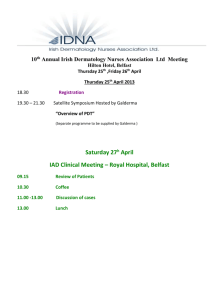
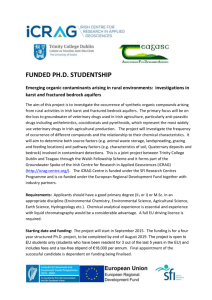

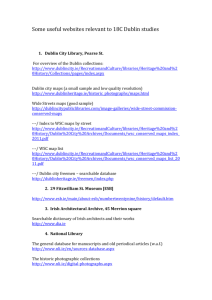
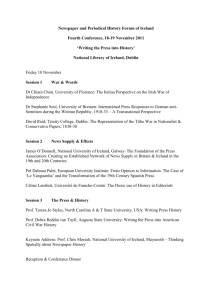
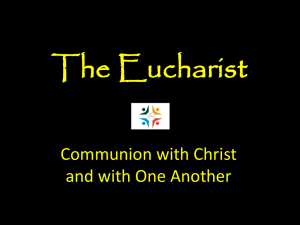

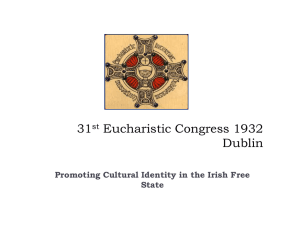
![South east presentation resources [pdf, 7.8MB]](http://s2.studylib.net/store/data/005225551_1-572ef1fc8a3b867845768d2e9683ea31-300x300.png)